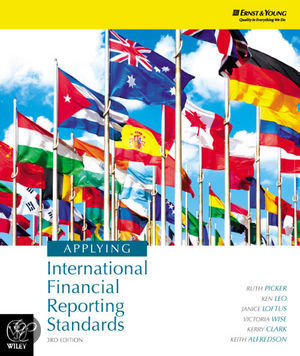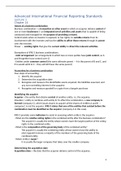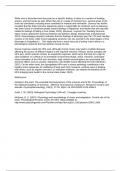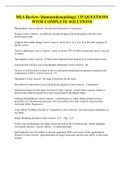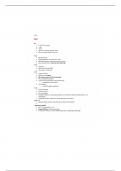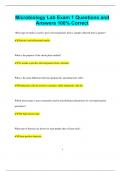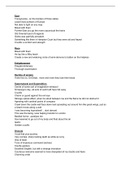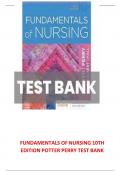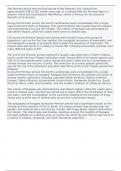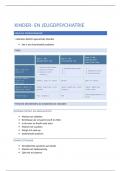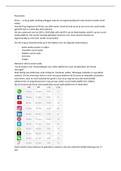Lecture 1
Chapter 14
Nature of a business combination
Business combination = a transaction or other event in which an acquirer obtains control of
one or more businesses (= an integrated set of activities and assets that is capable of being
conducted and managed for the purpose of providing a return).
Control exists when an investor is exposed, or has rights, to variable returns from its
involvement with the investee and has the ability to affect those returns through its power
over the investee.
Power → existing rights that give the current ability to direct the relevant activities.
Exemptions of IFRS 3 business combinations:
- Joint arrangement (an arrangement in which two or more parties have joint control, so A
and B together have control over C)
- Entities under common control (the same ultimate parent →A is the parent of B and C, and
if A would sell B to C – they will still have the same parent)
Accounting for a business combination
Four steps of accounting:
1. Identify the acquirer
2. Determine the acquisition date
3. Recognise and measure the identifiable assets acquired, the liabilities assumed, and
any non-controlling interest in the acquiree
4. Recognise and measure goodwill or a gain from a bargain purchase
Identifying the acquirer
Acquirer = the entity that obtains control of another entity, i.e. the acquiree.
Situation = entity A combines with entity B. To effect the combination, a new company is
formed (company C), which issues shares to acquire all the shares of entities A and B →
company C is not the acquirer. IFRS 3 states that one of the entities that existed before the
combination must be identified as the acquirer (company A in this case).
IFRS 3 provides some indicators to assist in assessing which entity is the acquirer:
- What are the relative voting rights in the combined entity after the business combination?
The acquirer is usually the entity whose owners have the largest portion of the voting
rights in the combined entity.
- What is the composition of the governing body of the combined entity?
The acquirer is usually the combining entity whose owners have the ability to
elect/appoint/remove a majority of the members of the governing body of the
combined entity.
- Which entity is larger?
It is usually the larger company that takes over the smaller company.
Determining the acquisition date
Acquisition date = the date that the acquirer obtains control of the acquiree.
1
,Recognition and measurement of assets acquired and liabilities assumed
Recognition
As of the acquisition date, the acquirer shall recognise, separately from goodwill, the
identifiable assets acquired, the liabilities assumed and any non-controlling interest in the
acquiree. Recognition of identifiable assets acquired and liabilities assumed is subject to the
following conditions:
1. Any expected future costs cannot be included in the calculation of assets acquired
and liabilities assumed.
Implications: if the liability is contingent (= a negative situation that may occur and
for which one ought to prepare) upon a future event, such as the legal outcome
against the acquiree, and there is a 50% chance that there will be a cash outflow,
they have to be recognised.
2. The item acquired or assumed must be part of the business acquired rather than the
result of a separate transaction.
Also, IFRS 3 notes that the acquirer might has to recognise assets and liabilities as a result of
the business combination that were not previously recognised by the acquiree (= for
example, internally generated intangibles).
Measurement → fair value (= the price that would be received to sell an asset or paid to
transfer a liability in an orderly transaction between market participants at the
measurement date).
Goodwill and gain on bargain purchase
Goodwill is determined by comparing the consideration transferred by the acquirer with
the FV of the net assets (assets – liabilities).
Consideration transferred
The consideration transferred is the sum of the acquisition-date FV of the assets (=
cash/shares/other assets) transferred by the acquirer, the liabilities incurred by the acquirer
to former owners of the acquiree, and the equity interest issued by the acquirer.
Equity instruments
If an acquirer issues its own shares as consideration, it needs to determine the FV of those
shares at the acquisition date. The acquiree does not have to record anything (the
transaction is between the acquirer and the shareholders of the acquiree).
Liabilities assumed
Future losses or other costs expected to be incurred as a result of the combination are not
liabilities of the acquirer and are therefore not included in the calculation of the fair value of
consideration paid.
Acquisition-related costs
Acquisition-related costs associated with a business combination are accounted for as
expenses in the periods in which they are incurred and the services are received. Thus, they
are not part of the consideration transferred.
2
, Case = the balance below represents the financial position of Whiting Ltd at 1/1/2016.
Balance as of 1/1/2016
Equipment 42.000 Share capital
Inventory 18.000 Preference (6.000 shares) 6.000
Accounts receivable 16.000 Ordinary (30.000 shares) 30.000
Patents 3.500 Retained earnings 21.500
Acc. Depreciation 10.000
Debentures 4.000
Accounts payable 8.000
79.500 79.500
At this date, the business of Whiting Ltd is acquired by Salmon Ltd, with Whiting Ltd going
into liquidation. The terms of acquisition are as follows:
1. Salmon Ltd is to take over all the assets of Whiting Ltd as well as the accounts
payable of Whiting Ltd.
2. Costs of liquidation of $350 are to be paid by Whiting Ltd with funds supplied by
Salmon Ltd.
3. Preference shareholders of Whiting Ltd are to receive two fully paid preference
shares in Salmon Ltd for every three shares held or, alternatively, $1 per share in cash
payable at acquisition date.
4. Ordinary shareholders of Whiting Ltd are to receive two fully paid ordinary shares in
Salmon Ltd for every share held or, alternatively, $2,50 in cash, payable half at the
acquisition date and half on 31 December 2016.
5. Debenture holders of Whiting Ltd are to be paid in cash out of funds provided by
Salmon Ltd. These debentures have a fair value of $102 per $100 debenture.
6. All shares being issued by Salmon Ltd have a fair value of $1,10 per share. Holders of
3.000 preference shares and 5.000 ordinary shares elect to receive the cash.
7. Costs of issuing and registering the shares issued by Salmon Ltd amount to $40 for
the preference shares and $100 for the ordinary shares.
8. Costs associated with the business combination and incurred by Salmon Ltd were
$1.000. The calculation of the consideration transferred in the business combination
to Salmon Ltd is shown.
9. The incremental borrowing rate for Salmon Ltd is 10% p.a.
Q1. What is the consideration transferred?
Cash: Costs of liquidation $350
Preference shareholders (3.000 × $1) $3.000
Ordinary shareholders
- payable immediately (1/2 × 5.000 × $2,50) $6.250
- payable later (1/2 × 5.000 × $2,50 × 0,909091) $5.682
Debentures, including premium ($4.000 × 1,02) $4.080 $19.362
Shares: Preference shareholders ((3.000/3*2) x $1,1) $2.200
Ordinary shareholders ((25.000*2) * $1,1) $55.000 $57.200
Consideration transferred $76.562
3


